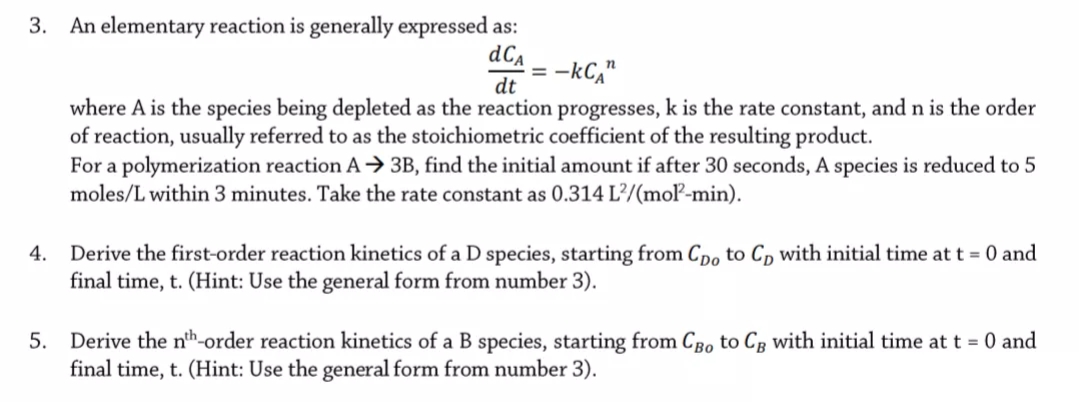3. An elementary reaction is generally expressed as: dCa =-kC," dt %3D where A is the species being depleted as the reaction progresses, k is the rate constant, and n is the order of reaction, usually referred to as the stoichiometric coefficient of the resulting product. For a polymerization reaction A → 3B, find the initial amount if after 30 seconds, A species is reduced to 5 moles/L within 3 minutes. Take the rate constant as 0.314 L'/(mol-min).
3. An elementary reaction is generally expressed as: dCa =-kC," dt %3D where A is the species being depleted as the reaction progresses, k is the rate constant, and n is the order of reaction, usually referred to as the stoichiometric coefficient of the resulting product. For a polymerization reaction A → 3B, find the initial amount if after 30 seconds, A species is reduced to 5 moles/L within 3 minutes. Take the rate constant as 0.314 L'/(mol-min).
Calculus: Early Transcendentals
8th Edition
ISBN:9781285741550
Author:James Stewart
Publisher:James Stewart
Chapter1: Functions And Models
Section: Chapter Questions
Problem 1RCC: (a) What is a function? What are its domain and range? (b) What is the graph of a function? (c) How...
Related questions
Question
Please help me with numbers 3-5

Transcribed Image Text:3. An elementary reaction is generally expressed as:
dCa
-kC,"
dt
where A is the species being depleted as the reaction progresses, k is the rate constant, and n is the order
of reaction, usually referred to as the stoichiometric coefficient of the resulting product.
For a polymerization reaction A → 3B, find the initial amount if after 30 seconds, A species is reduced to 5
moles/L within 3 minutes. Take the rate constant as 0.314 L²/(moľ-min).
Derive the first-order reaction kinetics of a D species, starting from Cpo to Cp with initial time at t = 0 and
final time, t. (Hint: Use the general form from number 3).
4.
Derive the nth-order reaction kinetics of a B species, starting from CBo to Cg with initial time at t = 0 and
final time, t. (Hint: Use the general form from number 3).
5.
Expert Solution
This question has been solved!
Explore an expertly crafted, step-by-step solution for a thorough understanding of key concepts.
Step by step
Solved in 2 steps

Knowledge Booster
Learn more about
Need a deep-dive on the concept behind this application? Look no further. Learn more about this topic, calculus and related others by exploring similar questions and additional content below.Recommended textbooks for you

Calculus: Early Transcendentals
Calculus
ISBN:
9781285741550
Author:
James Stewart
Publisher:
Cengage Learning

Thomas' Calculus (14th Edition)
Calculus
ISBN:
9780134438986
Author:
Joel R. Hass, Christopher E. Heil, Maurice D. Weir
Publisher:
PEARSON

Calculus: Early Transcendentals (3rd Edition)
Calculus
ISBN:
9780134763644
Author:
William L. Briggs, Lyle Cochran, Bernard Gillett, Eric Schulz
Publisher:
PEARSON

Calculus: Early Transcendentals
Calculus
ISBN:
9781285741550
Author:
James Stewart
Publisher:
Cengage Learning

Thomas' Calculus (14th Edition)
Calculus
ISBN:
9780134438986
Author:
Joel R. Hass, Christopher E. Heil, Maurice D. Weir
Publisher:
PEARSON

Calculus: Early Transcendentals (3rd Edition)
Calculus
ISBN:
9780134763644
Author:
William L. Briggs, Lyle Cochran, Bernard Gillett, Eric Schulz
Publisher:
PEARSON

Calculus: Early Transcendentals
Calculus
ISBN:
9781319050740
Author:
Jon Rogawski, Colin Adams, Robert Franzosa
Publisher:
W. H. Freeman


Calculus: Early Transcendental Functions
Calculus
ISBN:
9781337552516
Author:
Ron Larson, Bruce H. Edwards
Publisher:
Cengage Learning